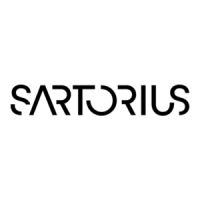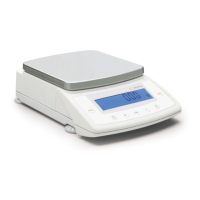Do you have a question about the Sartorius CPA64 and is the answer not in the manual?
Guidelines for storing and shipping the balance to prevent damage and ensure proper function.
Procedure for unpacking the balance and checking for any external damage.
Steps and considerations for properly installing the balance at the desired location.
Process to acclimate the balance to room temperature after exposure to cold.
Information on the control seal for balances verified for legal metrology in the EU.
Instructions for installing components for the CPA2P balance model.
Steps for installing components for the CPA2P-F balance, including filter pan usage.
Guidance on positioning and securing the draft shield on analytical balances.
Procedure for connecting the CPA26P and CPA225D models to their electronics box.
Instructions for installing the draft shield with a front opening on the balance.
Placing components for balances with rectangular pans and capacities up to 10 kg.
Placing the weighing pan for balances with rectangular pans and capacities over 10 kg.
Steps for connecting the balance to AC power supply via the adapter.
Information on using country-specific power cords with the AC adapter.
Safety guidelines for using plug-in AC adapters with the balance.
Safety guidelines for using the universal AC adapter (6971966).
Identification and explanation of the balance's display indicators and operating keys.
Instructions for below-balance weighing on analytical and precision balances.
Steps for performing below-balance weighing with the CPA2P microbalance.
Explanation of calibration purpose and key features for accurate measurements.
Requirements for calibrating balances used as legal measuring instruments.
Procedure for performing internal calibration and automatic adjustment using the balance's weight.
Details on automatic calibration and adjustment based on temperature and time.
Steps for performing external calibration using a calibration weight.
How to adapt the balance to individual requirements via the Setup menu.
Instructions on how to print current balance parameter settings.
Step-by-step guide to setting balance parameters using menu codes.
Detailed overview of available parameter settings and their options.
Configuring measurement IDs, time, date for records, and display brightness.
Explanation of function keys (F, CF) used in application programs.
Using the program to weigh components into a defined total weight.
Determining the number of parts based on a reference sample weight.
Using a reference balance for higher precision in counting large quantities.
Obtaining weight readouts in percent relative to a reference weight.
Determining weights of unstable samples by averaging multiple readings.
Switching the display between different weight units (e.g., grams, kg).
Generating printouts with weights, values, and identification codes for documentation.
Examples of printouts showing different data formats and ID codes.
Configuring printouts of initialization values for active application programs.
Generating printouts compliant with ISO/GLP standards for ambient conditions.
Details on the balance's interface port for computer connection and functions.
Default interface settings for transmission rate, parity, stop bits, and handshake.
How non-verified digits are identified on printouts based on menu settings.
Formats for sending control commands to the balance via the interface port.
Ensuring data communication by matching parameters and using handshake methods.
Managing data output via print commands, automatic output, and output speeds.
Detailed pin assignments for the female and male interface connectors.
Cautionary note regarding incorrect pin assignments in pre-wired RS-232 cables.
Diagram illustrating the cabling connections for RS-232C/V24 communication.
Steps to prepare the CPA2P model for safe transport, including component removal.
Steps to prepare the CPA2P-F model for safe transport, including filter pan removal.
Information on Sartorius service contracts and authorized repair procedures.
Guidelines for safely cleaning the balance, including stainless steel surfaces.
Procedures for conducting safety inspections and recommended electrical checks.
Guidelines for the disposal of packaging, equipment, and batteries according to EU legislation.
Optional accessories: data printer for statistics and remote display.
External rechargeable battery packs for extended operation.
Carrying cases designed for analytical or standard draft shield models.
Software for data transfer and associated RS-232C adapter cables.
Kits for density determination, antistatic pans, calibration weights, and AC adapters.
Optional draft shield chamber for specific CPA and GCA balance models.
Accessories like draft shield covers, data cables, and adapters for connectivity.
Universal remote control switches, T-connectors, and below-balance weighing hangers.
Optional weighing bowls of various volumes and dust covers for display units.
Regulation of non-automatic weighing instruments for mass determination in legal metrology.
Description of Sartorius services for initial verification and EC verification.
Information on the validity of verification and contact points for legal metrology services.
Identification of plates, CE mark, metrology stickers, and model designations on balances.
Example of a plate showing the model designation and other identifying marks.
Example of a descriptive plate on a weighing instrument that has already been verified.
Guidelines for storing and shipping the balance to prevent damage and ensure proper function.
Procedure for unpacking the balance and checking for any external damage.
Steps and considerations for properly installing the balance at the desired location.
Process to acclimate the balance to room temperature after exposure to cold.
Information on the control seal for balances verified for legal metrology in the EU.
Instructions for installing components for the CPA2P balance model.
Steps for installing components for the CPA2P-F balance, including filter pan usage.
Guidance on positioning and securing the draft shield on analytical balances.
Procedure for connecting the CPA26P and CPA225D models to their electronics box.
Instructions for installing the draft shield with a front opening on the balance.
Placing components for balances with rectangular pans and capacities up to 10 kg.
Placing the weighing pan for balances with rectangular pans and capacities over 10 kg.
Steps for connecting the balance to AC power supply via the adapter.
Information on using country-specific power cords with the AC adapter.
Safety guidelines for using plug-in AC adapters with the balance.
Safety guidelines for using the universal AC adapter (6971966).
Identification and explanation of the balance's display indicators and operating keys.
Instructions for below-balance weighing on analytical and precision balances.
Steps for performing below-balance weighing with the CPA2P microbalance.
Explanation of calibration purpose and key features for accurate measurements.
Requirements for calibrating balances used as legal measuring instruments.
Procedure for performing internal calibration and automatic adjustment using the balance's weight.
Details on automatic calibration and adjustment based on temperature and time.
Steps for performing external calibration using a calibration weight.
How to adapt the balance to individual requirements via the Setup menu.
Instructions on how to print current balance parameter settings.
Step-by-step guide to setting balance parameters using menu codes.
Detailed overview of available parameter settings and their options.
Configuring measurement IDs, time, date for records, and display brightness.
Explanation of function keys (F, CF) used in application programs.
Using the program to weigh components into a defined total weight.
Determining the number of parts based on a reference sample weight.
Using a reference balance for higher precision in counting large quantities.
Obtaining weight readouts in percent relative to a reference weight.
Determining weights of unstable samples by averaging multiple readings.
Switching the display between different weight units (e.g., grams, kg).
Generating printouts with weights, values, and identification codes for documentation.
Examples of printouts showing different data formats and ID codes.
Configuring printouts of initialization values for active application programs.
Generating printouts compliant with ISO/GLP standards for ambient conditions.
Details on the balance's interface port for computer connection and functions.
Default interface settings for transmission rate, parity, stop bits, and handshake.
How non-verified digits are identified on printouts based on menu settings.
Formats for sending control commands to the balance via the interface port.
Ensuring data communication by matching parameters and using handshake methods.
Managing data output via print commands, automatic output, and output speeds.
Detailed pin assignments for the female and male interface connectors.
Cautionary note regarding incorrect pin assignments in pre-wired RS-232 cables.
Diagram illustrating the cabling connections for RS-232C/V24 communication.
Steps to prepare the CPA2P model for safe transport, including component removal.
Steps to prepare the CPA2P-F model for safe transport, including filter pan removal.
Information on Sartorius service contracts and authorized repair procedures.
Guidelines for safely cleaning the balance, including stainless steel surfaces.
Procedures for conducting safety inspections and recommended electrical checks.
Guidelines for the disposal of packaging, equipment, and batteries according to EU legislation.
Optional accessories: data printer for statistics and remote display.
External rechargeable battery packs for extended operation.
Carrying cases designed for analytical or standard draft shield models.
Software for data transfer and associated RS-232C adapter cables.
Kits for density determination, antistatic pans, calibration weights, and AC adapters.
Optional draft shield chamber for specific CPA and GCA balance models.
Accessories like draft shield covers, data cables, and adapters for connectivity.
Universal remote control switches, T-connectors, and below-balance weighing hangers.
Optional weighing bowls of various volumes and dust covers for display units.
Regulation of non-automatic weighing instruments for mass determination in legal metrology.
Description of Sartorius services for initial verification and EC verification.
Information on the validity of verification and contact points for legal metrology services.
Identification of plates, CE mark, metrology stickers, and model designations on balances.
Example of a plate showing the model designation and other identifying marks.
Example of a descriptive plate on a weighing instrument that has already been verified.
| Maximum Capacity | 64 g |
|---|---|
| Readability | 0.1 mg |
| Pan Size | Ø 85 mm |
| Display | LCD |
| Repeatability | 0.1 mg |
| Linearity | ± 0.2 mg |
| Interface | RS232 |
| Power Supply | AC Adapter |
| Calibration | Internal |
| Operating Temperature | +10°C to +30°C |











